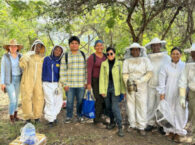Interdisciplinary Design for Energy & Sustainability
Metrics
Community
Dane CountyCommunity Size
44,411University
University of Wisconsin - MadisonProgram
UniverCity YearCase Type
Project StoriesFocus Areas
EquityDiscipline
EngineeringRegion
EPA Region 5, USAUniversity Department Code
EngineeringSustainable Development Goals
07 Affordable and Clean EnergyPopulation Type
Business Owners and ConsumersClean Fuel Partners (CFP) owns several anaerobic digesters and currently uses them to produce electricity to be sold to a local utility. However, this arrangement is only profitable
because the two companies have a power purchase agreement (PPA) with one another. Once the
PPA is up, Clean Fuel Partners needs to find a different use for the biogas produced by their
digesters, as well as for the fiber produced as a byproduct in the process. The fiber especially
needs to be transported outside of the Yahara watershed as to not pollute the watershed with
excess nutrients.
Our team has come up with the option of scrubbing the biogas of impurities, and then
injecting it into a natural gas pipeline to generate revenue from Renewable Identification
Numbers (RINs) through companies in California. RINs have a set value based on the material
made to produce the natural gas. Based on current feed into digesters at Clean Fuel Partners,
there would be a mix of D3 and D5 RINs. However, in order to increase the profit margins, we
have decided to pursue solely D3 RINs, as they are more valuable, and are made almost entirely
from cellulosic matter (manure). Based on current gas production this would total between
$6,200-$9,300 a day for two running digesters.
The process for producing pipeline ready gas requires the purchase and implementation
of several new technologies including a gas scrubber, a compressor, tube trailers, and storage
tanks. A gas scrubber is required to clean the biogas of impurities, until it is 96.7% methane.
Amine scrubbers are the most efficient technology for the job, but have a high initial investment
of approximately $2.4 million. Methane must be compressed for transport; thus, a compressor is
needed on site, which totals $100,000. Tube trailers are used to transport natural gas to the
injection point where it will be added to the pipeline, and it would cost between $500 and $1,000
4
for a third party to transport the gas every eight days. As a fall back should anything happen to
the compressor, or to the tube trailers, we also recommend purchasing portable storage tanks for
the gas, which would be a $4,000 investment.
The fiber byproduct of the digesters is currently not profitable for Clean Fuel Partners. In
order to make it a more valuable part of the process, we have decided to pelletize it. Pelletizing
fiber removes a large amount of the moisture from it, reducing transportation costs. The fiber
pellets can then serve as a marketable product such as biofertilizer for farms or gardens.
Similarly, with the natural gas process, there are several new technologies that need to be put in
place in order to pelletize the fiber.
The first new technology that would need to be put in place for the fiber pelletizing
process is a rotary drum dryer, in order to remove the vast majority of the moisture from the fiber
product. This would have an upfront cost of $480,000, and an operational cost of $846 a day.
After the fiber has been dried, it needs to be pelletized into the final product shape. The pelletizer
costs $300,000, and has a daily operational cost of $300. Assuming daily earnings between
$2,500 and $8,500, it would take approximately half of a year to pay for the new fiber
machinery.
The design that we are suggesting has a large upfront cost, but the payback period for the
entire initial investment based on RIN prices and fiber prices would only be one to two years.
Also, the technologies for pipeline injection are being used by other natural gas producers, so it
is proven to work. Farms that produce biogas also pelletize their fiber using a similar process to
our proposed option, so this is also a viable option.
Future considerations include implementing a fourth digester to increase gas production.
Another option would be looking into a source for more manure, so that more cellulosic methane
5
can be produced. This would greatly increase revenue but would involve the costs associated
with transporting more manure, as well as where to get the manure from.
Read the final student report delivered to the local gov/community partner.
UniverCity Year Contact Info
Gavin Luter
Managing Director
gavin@cows.org
608-261-1141
University Faculty Contact
Scott Williams
Civil and Environmental Engineering
spwilliams@wisc.edu
Local Government / Community Contact
Lauren Kuhl
Legislative Management System Specialist
Kuhl.Lauren@countyofdane.com


